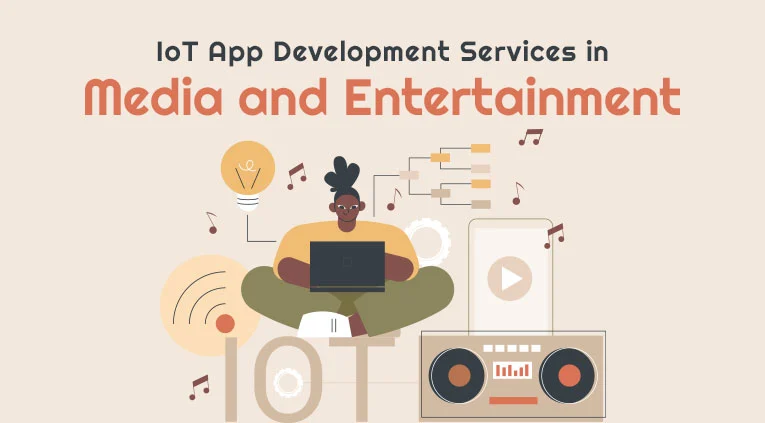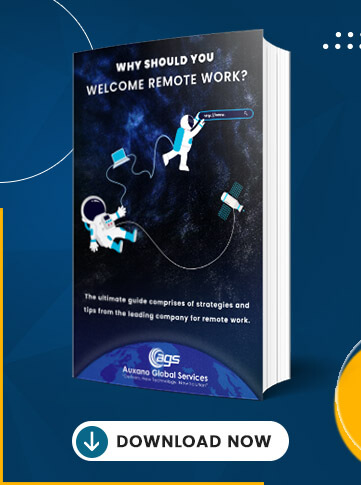“Smart” education is a synergy of e-learning and distance learning and a fundamental element for the development of a digital society. It is about technology and a special philosophy of education. Since information is freely available, knowledge becomes as accessible as possible.
The Internet of Things (IoT) has rapidly become a major trend in the technology industry. This technology connects devices, sensors, and networks to exchange data that can be used to improve processes and solve complex problems. In recent years, IoT App Development has made its way into education, creating an entirely new ecosystem for students and educators alike. IoT in education provides a unique opportunity to leverage technology for improved educational outcomes.
With the right approach, IoT can help educators and students achieve better outcomes and improve the quality of education for years to come.
Before going into detail, let’s find the role of IoT in the education sector…
Role of IoT (Internet of Things) Technology in the Education Sector
As a rule, the introduction of modern progressive technologies has a positive effect on the development of educational programs by students. Moreover, the students themselves positively and with interest perceive the introduction and use of such systems. In general, IoT App Development makes it possible to introduce an interactive approach to learning at a new level, to apply intelligent systems, and to adapt the educational process to each student. Such systems help to ensure constant communication between teachers and students, making it possible to conduct classes considering the needs and requests of the target audience.
The variety of devices and the possibility of combining them in one digital environment can significantly improve the quality of the learning process. There are several areas of using the Internet of things in education. One of them concerns security, accounting issues, knowledge control, and class attendance. Student identification is usually carried out using RFID tags or smart cards. More modern systems allow the use of a mobile phone, smartwatch, and even video cameras with a face recognition system for these purposes. Electronic journals associated with the personal identification system contain information on attendance, the results of mastering educational programs, and personal electronic accounts of students with educational materials.
The Education app development offers many opportunities for collaboration and cooperation to improve the interaction between students and teachers. More so, between students, they create opportunities for active learning in a safe environment. The use of IoT Solutions allows students to express their creativity, express their opinions, demonstrate their mastery of concepts, and increase their academic performance while exploring real-life learning scenarios.
While most schools can only dream of implementing the Internet of Things in their classrooms, these modern interactive and interconnected solutions offer new perspectives on learning and encourage students to pursue knowledge acquisition.
Let’s get into some statistics…
Statistics of IoT in the Education Industry
The IoT in Education Market is expected to experience robust growth from 2023 to 2032 due to the numerous advantages offered by IoT devices. These devices provide reliable access to multiple communication channels and online learning resources, enhancing the educational experience for students. Additionally, they enable real-time monitoring of students’ learning progress, allowing teachers to offer personalized instruction and support.
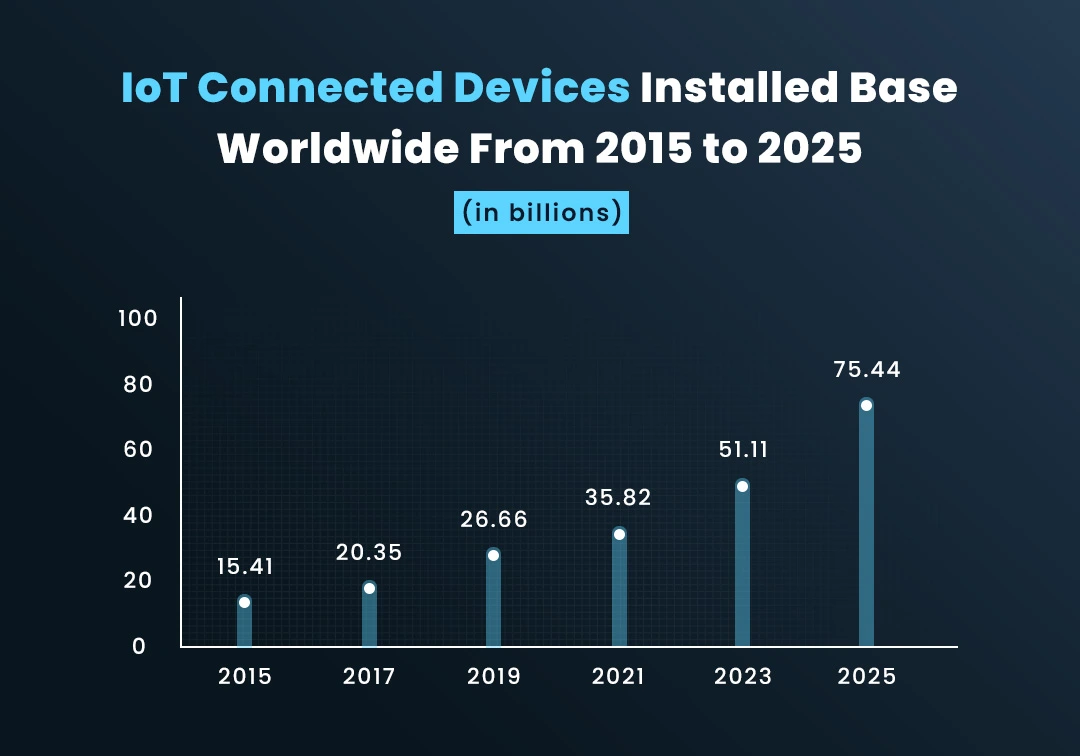
The popularity of e-learning has surged in recent years, and it is predicted that over 75 billion devices will be integrated with IoT technologies by 2025, as per an eLearning Industry Report.
This trend will further drive students’ interest in e-learning courses, providing them with real-time access to videos and tutorials. If you are also interested in the e-learning education business, then rely on the best Elearning App Development Company.
The tablets and mobiles segment is projected to experience a substantial CAGR until 2032, making it the primary device type in the IoT in the education market. The rising global sales of smartphones are driving this growth as students seek better access to online learning resources. Virtual communication software, such as Zoom, is also becoming increasingly prevalent in education, with over 90,000 schools in nearly 20 countries employing it to facilitate e-learning. Additionally, students are beginning to recognize the benefits of using tablets instead of traditional textbooks.
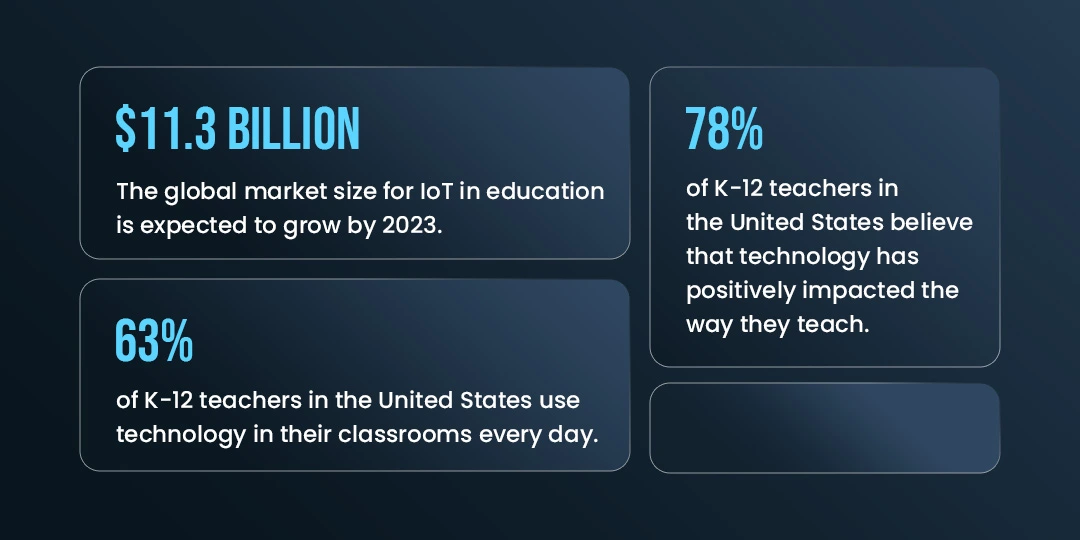
1. The global market size for IoT in education is expected to grow from $4.8 billion in 2018 to $11.3 billion by 2023, at a compound annual growth rate (CAGR) of 18.8%. (MarketsandMarkets)
2. 78% of K-12 teachers in the United States believe that technology has positively impacted the way they teach, and 72% think that technology helps them better understand the needs of their students. (PBS Learning Media)
3. 63% of K-12 teachers in the United States use technology in their classrooms every day.
All these statistics show how the application of IoT is increasing in education. To gain a deeper understanding of how IoT has the potential to transform the education landscape, it’s essential to explore some practical examples of IoT implementation in education.
Top Practical Examples of IoT in Education
The Internet of Things (IoT) can potentially revolutionize how we approach education. IoT devices can be used to improve teaching and learning outcomes, streamline administrative tasks, and create a more connected and efficient learning environment. Here are some practical examples of IoT in education:
1. Kajeet SmartBus
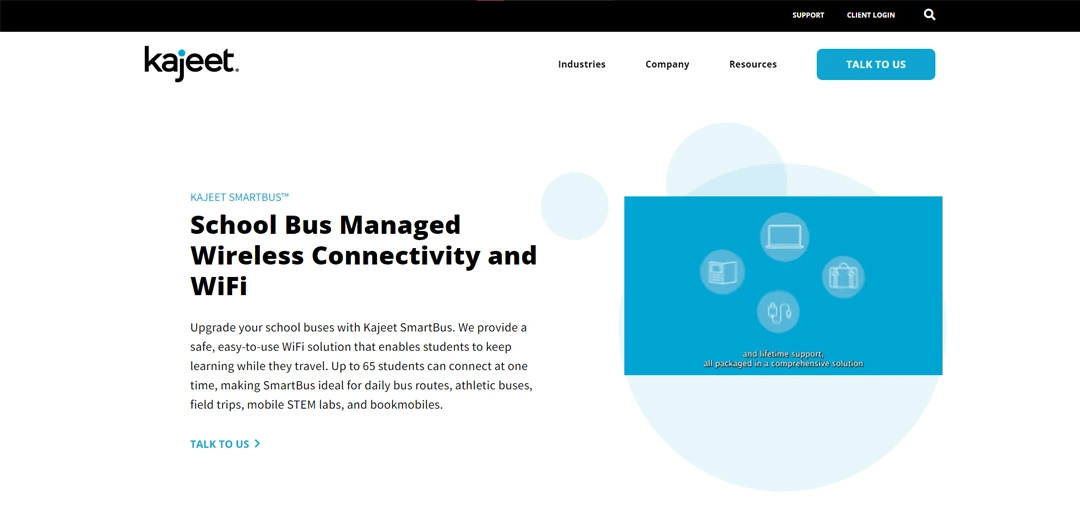
The Kajeet SmartBus is a mobile hotspot that provides internet connectivity for students while they are on the school bus. This is particularly useful for students who may not have internet access at home or have a long school commute. With the Kajeet SmartBus, students can access online resources, complete homework assignments, and stay connected with their teachers and peers. The Kajeet SmartBus also provides a safe and filtered internet experience, protecting students from inappropriate content.
2. C-PEN

The C-PEN is a handheld scanning device that allows students to scan printed text and hear it read aloud. This is particularly useful for students with dyslexia or other reading difficulties. The C-PEN can also be used to translate text into different languages, making it a valuable tool for students who are learning English as a second language. By using the C-PEN, students can improve their reading comprehension and language skills.
3. IPEVO VZ-X Wireless Document Camera
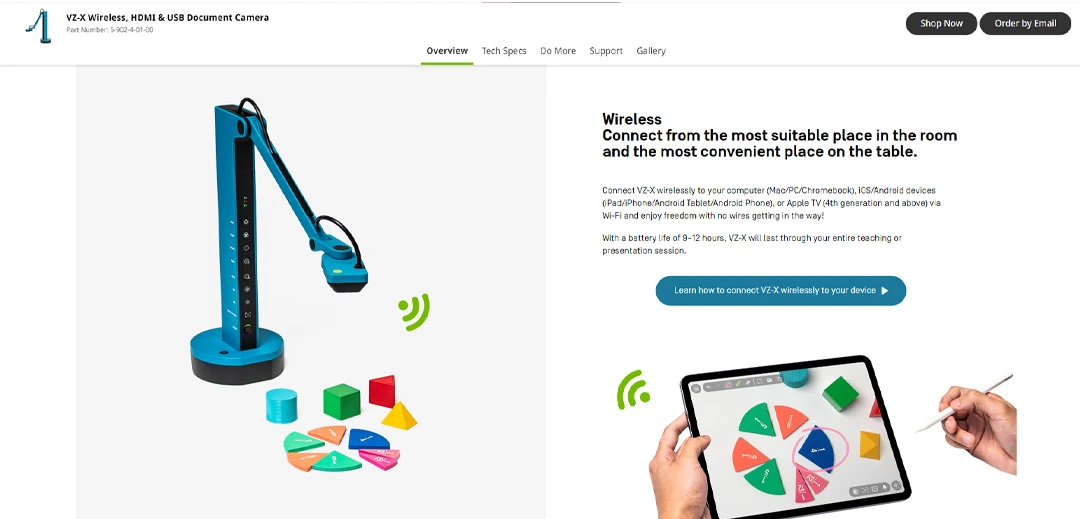
The IPEVO VZ-X Wireless Document Camera is a device that allows teachers to project documents and objects onto a screen or whiteboard. This is particularly useful for science and math classes, where teachers may need to demonstrate concepts using physical objects. With the IPEVO VZ-X, teachers can project images in real-time, making it easier for students to understand complex concepts.
4. Tynker
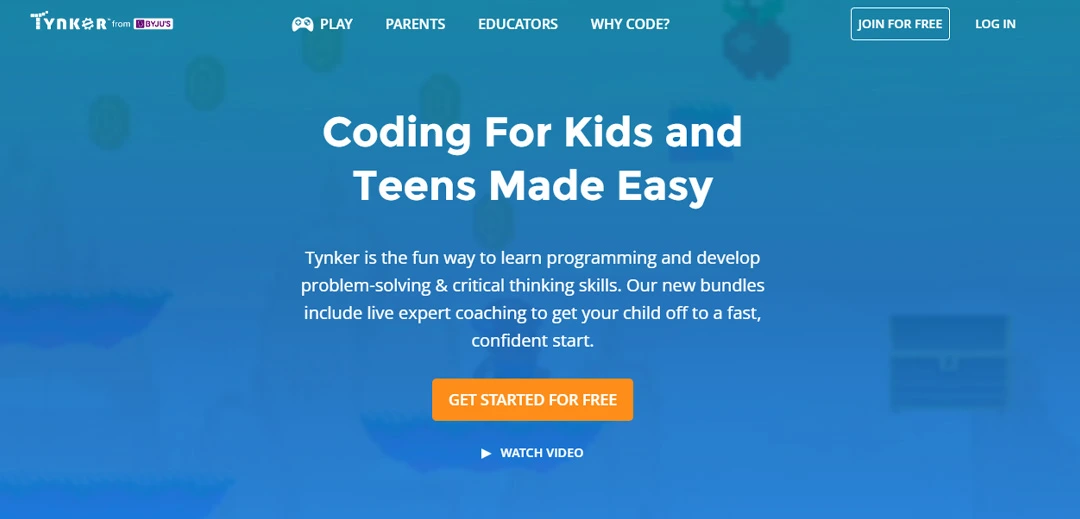
Tynker is an online platform that teaches students how to code using visual programming. With Tynker, students can learn how to program robots, design video games, and create animations. Tynker provides a gamified learning experience, making it engaging and fun for students. By learning how to code, students can develop important problem-solving and critical-thinking skills that will be useful in many areas of their lives.
5. Blackboard
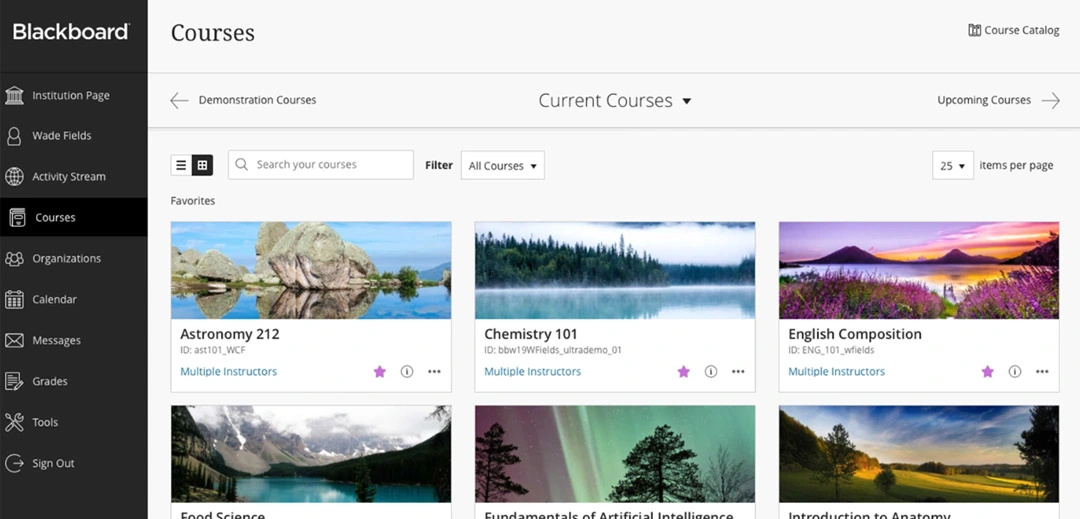
Blackboard is a learning management system (LMS) that allows teachers to create and deliver online courses. With Blackboard, teachers can post course materials, create assignments, and communicate with students. Blackboard also provides tools for grading and assessment, making it easier for teachers to track student progress. By using Blackboard, teachers can create a more flexible and accessible learning experience for their students.
6. Kaltura
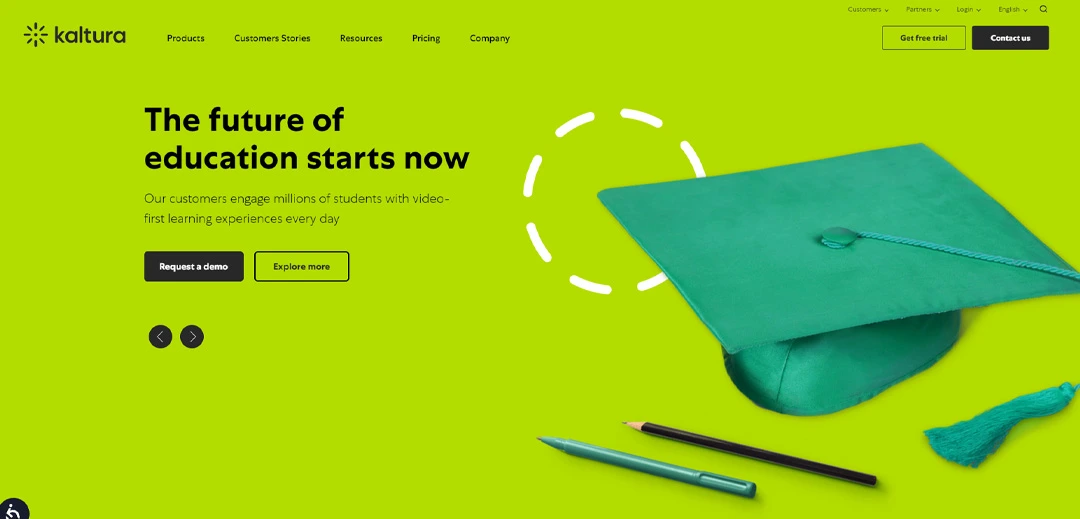
Kaltura is a video platform that allows teachers to create and share video content with their students. With Kaltura, teachers can record lectures, create video assignments, and provide feedback to students. Kaltura also provides analytics tools, allowing teachers to track student engagement with their videos. By using video content, teachers can create a more engaging and interactive learning experience for their students.
These real-life examples of the Internet of Things in Education show how this technology can be used effectively to improve the learning experience of students. Now let’s see how IoT is being applied in education.
Applications of IoT in Education
From smart boards to IoT-powered attendance systems, there are many potential applications for IoT in education; let’s explore them below:
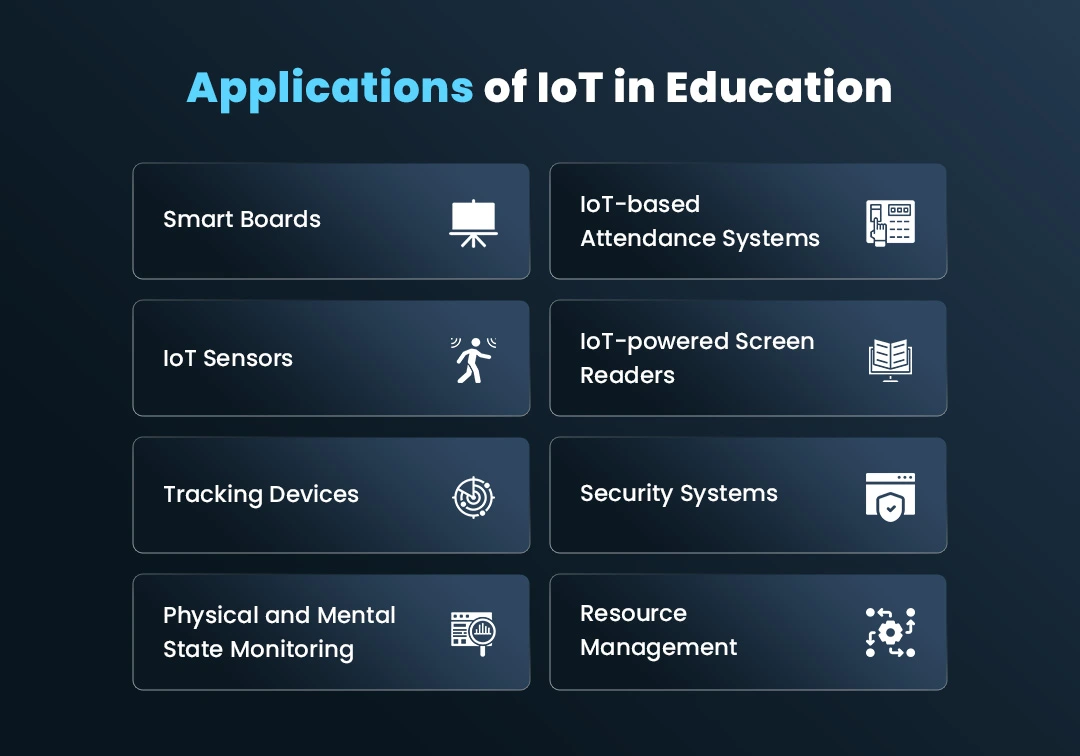
1. Smart Boards
Smart boards are an excellent example of IoT technology in the education industry. These interactive whiteboards are becoming increasingly popular in classrooms all over the world. Smart boards are designed to be more engaging and interactive than traditional chalkboards or whiteboards. These boards are equipped with sensors that can detect touch, movement, and other interactions, allowing students to write, draw, and interact with the board. Additionally, smart boards can be integrated with other IoT devices, such as tablets or smartphones, creating an entirely new way of interacting with learning materials.
2. IoT-based Attendance Systems
IoT-powered attendance systems have the potential to streamline attendance taking in schools. With these systems, students can simply tap a card or scan a QR code to check in, eliminating the need for manual attendance taking. This can save teachers significant time and make it easier for administrators to track attendance. Furthermore, these systems can be connected to other IoT devices, such as smart boards or security systems, to create a more integrated and efficient learning environment.
3. IoT Sensors
IoT sensors are another exciting application of IoT in education. These sensors can be used to track the movement and behavior of students in the classroom, providing teachers with valuable data that can be used to improve their teaching methods. For example, IoT sensors can track how long a student spends on a particular task or how often they ask for help. This data can be used to create personalized learning experiences that are tailored to each student’s unique needs.
4. IoT-powered Screen Readers
IoT-powered screen readers are designed to assist visually impaired students in the classroom. These devices use IoT sensors to detect the presence of a student and automatically adjust the settings on the classroom screen to accommodate their needs. For example, the screen reader may enlarge text or adjust the contrast to make reading easier for the student. This technology provides a more inclusive learning experience for all students, regardless of their physical abilities.
5. Tracking Devices
Tracking devices are becoming increasingly popular in the education industry. To track their location, these devices can be attached to school equipment, such as laptops or tablets. This technology can be particularly useful for preventing theft or loss of expensive school equipment. Additionally, tracking devices can be used to monitor students’ movement during field trips or other school activities, ensuring their safety and security.
6. Security Systems
IoT-powered security systems are designed to improve the safety of students and faculty in schools. These systems use IoT sensors to detect unauthorized access to school buildings or other sensitive areas. Additionally, these systems can be used to monitor the movement of students during the school day, ensuring that they are safe and accounted for at all times.
7. Physical and Mental State Monitoring of Students
IoT sensors can also be used to monitor students’ physical and mental states in the classroom. For example, sensors can be used to detect changes in heart rate or blood pressure, indicating that a student may be experiencing anxiety or stress. This data can be used to identify students who may be struggling with mental health issues and provide them with the support they need to succeed in school.
8. Resource Management
IoT can also be used to manage resources in schools more efficiently. For example, smart lighting systems can automatically adjust classroom lighting based on the amount of natural light available. This can reduce energy consumption and save schools money on their utility bills. Additionally, IoT sensors can be used to monitor classroom temperature and humidity levels, ensuring that they are kept at optimal levels for learning.
The integration of the Internet of Things into education has opened many possibilities for innovative and engaging learning experiences. Now let’s dive into the advantages that IoT offers to the education sector.
Benefits of using IoT in Education
The Internet of Things (IoT) is a revolutionary technology that connects physical devices, sensors, and other objects to the internet, enabling them to send and receive data. IoT has numerous applications in various industries, including education. By leveraging IoT, educators, and students can benefit from an array of Advantages of IoT in education that enhances the learning experience.
Here are the benefits of using IoT in education.
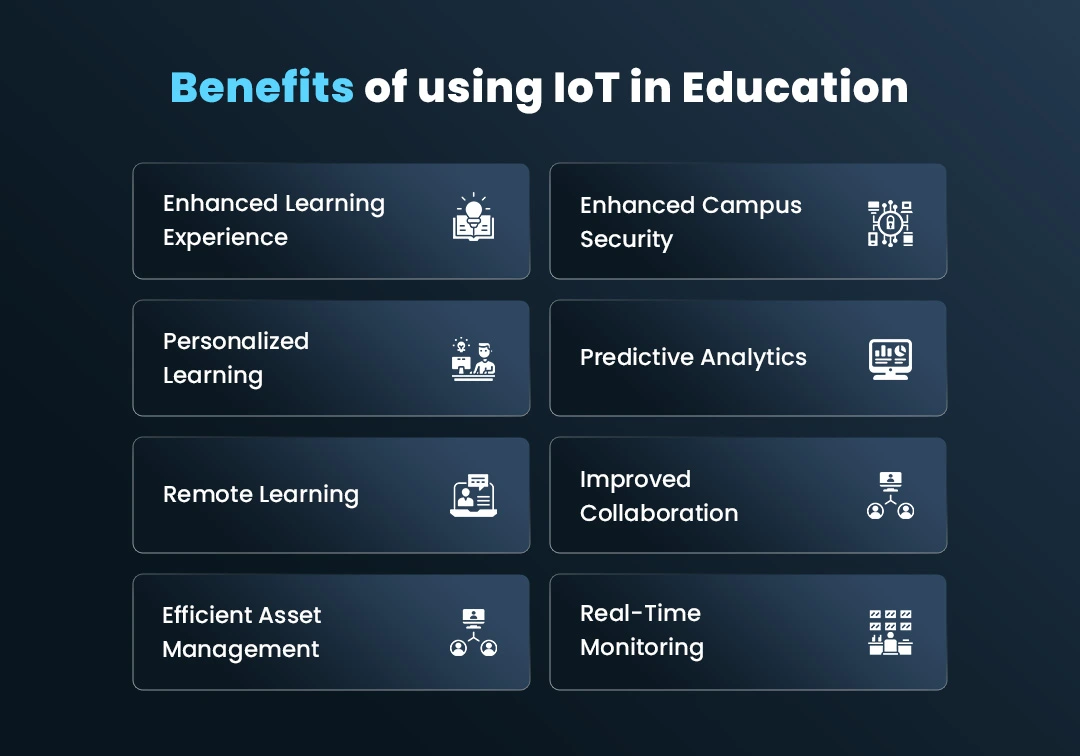
1. Enhanced Learning Experience
IoT devices can provide students with a more engaging and interactive learning experience. For example, IoT-enabled smart boards can allow teachers to create a more interactive and personalized learning environment. The smart board can display digital content, such as videos, images, and interactive quizzes, enabling students to engage with the material more meaningfully. In addition, IoT-enabled devices can provide real-time feedback and analytics, allowing educators to track student progress and adjust their teaching methods accordingly.
2. Enhanced Campus Security
IoT-enabled security systems can enhance campus security by providing real-time surveillance and monitoring. For instance, IoT sensors can be used to monitor access points, such as doors and windows, and send alerts to security personnel in case of any suspicious activity. Furthermore, IoT devices can also be used to track the movement of students and faculty on campus, ensuring their safety.
3. Personalized Learning
IoT can enable personalized learning experiences for students. Educators can monitor individual student progress using IoT-enabled devices and tailor the learning experience accordingly. For example, IoT sensors can track student engagement levels and send notifications to educators when a student is not engaging with the material. This can help educators provide additional support to struggling students and adjust their teaching methods to suit individual learning styles.
4. Predictive Analytics
IoT-enabled devices and sensors can collect data on various aspects of the learning environment, such as student engagement levels, attendance rates, and academic performance. This data can be analyzed using predictive analytics algorithms to identify patterns and trends, enabling educators to make data-driven decisions to improve the learning experience. For example, predictive analytics can help educators identify students at risk of falling behind and provide them with additional support before they start to struggle.
5. Remote Learning
IoT Application Development can enable remote learning by providing students with access to digital resources, such as digital textbooks and educational videos. IoT-enabled collaboration tools can also facilitate real-time communication and collaboration between students and teachers, enabling them to learn and work together regardless of their location. This can be especially beneficial for students who are unable to attend classes in person due to geographic or other constraints, as it provides them with an opportunity to interact and learn with their peers and educators.
6. Improved Collaboration
IoT devices can improve collaboration between students and teachers. For example, IoT-enabled collaboration tools can facilitate real-time communication and collaboration among students and teachers. This can be especially beneficial for distance learning programs, where students and teachers may be located in different parts of the world. Elearning mobile app development can also provide students with access to online resources, such as digital textbooks and educational videos, enabling them to collaborate and learn together.
7. Efficient Asset Management
IoT can help schools and universities to manage their assets more efficiently. For example, IoT sensors can be used to track the location of equipment, such as laptops and projectors, making it easier for administrators to locate and manage these assets. This can also reduce the risk of theft and loss, ensuring that valuable resources are kept secure.
8. Real-Time Monitoring
IoT devices can provide real-time monitoring of various aspects of the learning environment, such as temperature, humidity, and air quality. This can help to ensure that students and faculty are learning and working in a safe and healthy environment. IoT sensors can also be used to monitor equipment, such as computers and printers, ensuring that they are functioning properly and reducing downtime.

Despite all these potential benefits that the application of IoT in the education sector offers, It comes with lots of challenges and issues.
Let’s explore this in the section below!
Challenges of IoT in Education and How to Solve Them.
The Internet of Things (IoT) is a rapidly growing technology that has the potential to revolutionize many industries, including education. Developing an educational app can provide several benefits, such as personalized learning experiences, real-time feedback, and remote learning. However, like any emerging technology, IoT in education faces several challenges that need to be addressed to ensure its successful implementation. Let’s explore the challenges of IoT in education and how to solve them.
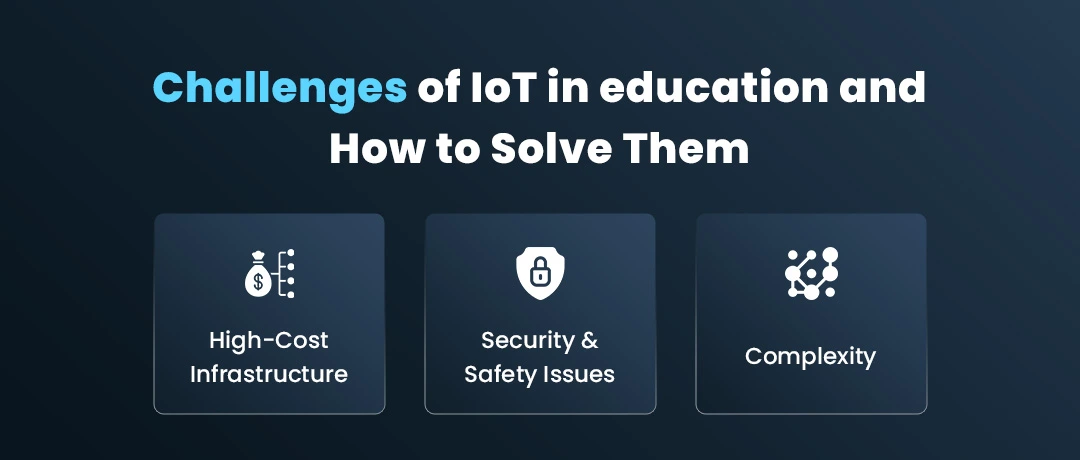
1. High-Cost Infrastructure
The first and most prominent challenge of implementing IoT in education is the high cost of infrastructure. IoT devices require a significant hardware, software, and networking infrastructure investment. Schools and universities may not have the budget to implement IoT solutions on a large scale.
One way to solve this challenge is to start small. Schools and universities can begin by implementing IoT Solutions for education in a limited capacity, such as using IoT-enabled devices in classrooms to monitor temperature and humidity levels. This can help schools and universities understand IoT’s benefits and develop a roadmap for future IoT implementations.
Another way to reduce the cost of infrastructure is to leverage cloud computing. Cloud-based IoT platforms can reduce the need for on-premise hardware and software, significantly lowering infrastructure costs. Cloud-based platforms can also provide scalability and flexibility, allowing schools and universities to expand their IoT implementations as their needs grow.
2. Security & Safety Issues
The second significant challenge of IoT in education is security and safety. IoT devices can be vulnerable to cyber attacks, compromising sensitive information and disrupting school operations. IoT devices can also pose safety risks if not properly installed or maintained.
Schools and universities must prioritize security and safety in their IoT implementations to address these challenges. This includes implementing security protocols and encryption measures to protect sensitive information, such as student data and financial information. It also means conducting regular security audits and vulnerability assessments to identify and address potential security risks.
Schools and universities should also prioritize safety when implementing IoT solutions. This includes properly installing and maintaining IoT devices, ensuring they meet safety standards and regulations, and training staff and students on how to use them safely.
3. Complexity
The third significant challenge of IoT in education is complexity. IoT solutions can be complex and challenging to implement, particularly for schools and universities with limited technical expertise. IoT solutions may require integration with existing systems, such as student information systems, learning management systems, and other educational technologies.
To address this challenge, schools and universities must invest in training and education to develop the necessary technical expertise. This can include partnering with technology vendors to provide training and support, hiring dedicated technical staff, and providing ongoing professional development opportunities for teachers and administrators.
Another way to simplify IoT implementations is to leverage pre-built IoT solutions. Many technology vendors offer pre-built IoT solutions designed specifically for education, such as smart classroom solutions that include IoT-enabled devices for monitoring temperature, lighting, and air quality. These pre-built solutions can simplify the implementation process and reduce the burden on IT personnel.
Implementing IoT in the education industry can be a challenging task that needs to be addressed to ensure.
How Auxano Global Services can help implement IoT in Education Industry?
Auxano Global Services is a leading IoT App Development Company that has a team of experienced developers who can provide customized solutions to meet the specific requirements of the education industry. Here’s how we can help implement IoT in the education industry:
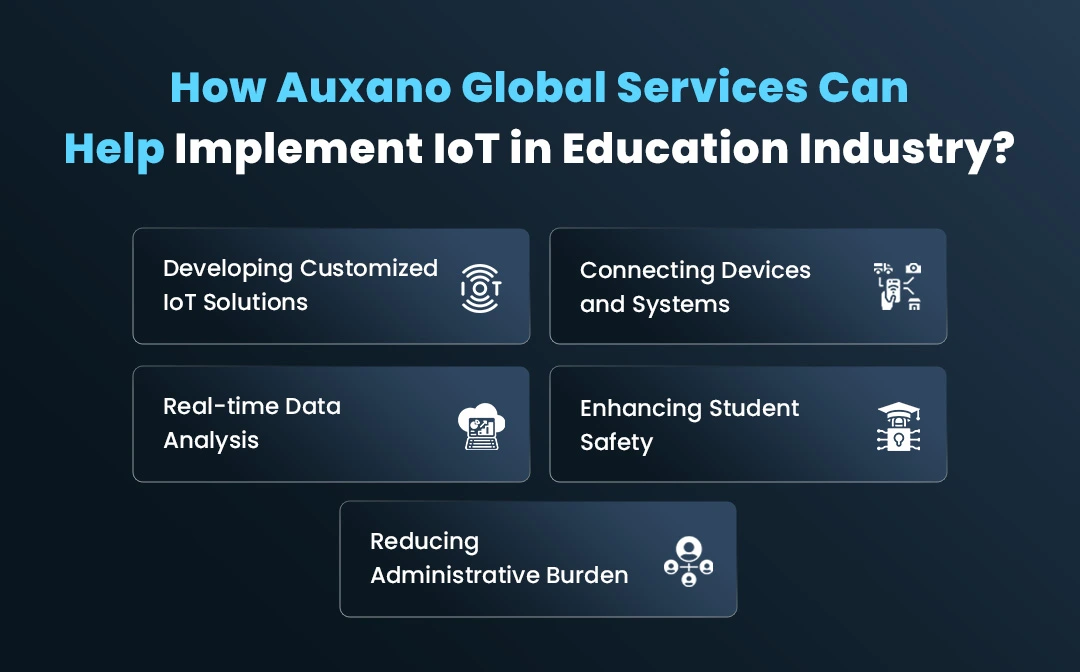
1. Developing Customized IoT Solutions
The education industry has unique requirements, and a one-size-fits-all solution may not work. Our professionals can develop customized IoT solutions that can cater to the specific needs of the education industry. We can work with schools, colleges, and universities to identify their requirements and develop solutions accordingly.
2. Connecting Devices and Systems
One of the primary benefits of IoT is the ability to connect devices and systems. The Learning app development experts can help schools, colleges, and universities connect devices and systems, such as smart boards, projectors, attendance systems, etc. This can enable teachers to control the devices and systems remotely and enhance the learning experience for students.
3. Real-time Data Analysis
IoT can provide real-time data analysis, which can help teachers and administrators make informed decisions. Auxano Global Services offer IoT App Development Services that can collect data such as student attendance, performance, and behavior. This data can be analyzed to identify patterns and trends, which can help teachers customize their teaching methods for individual students.
4. Enhancing Student Safety
Student safety is a top priority for schools, colleges, and universities. We can develop IoT solutions that can enhance student safety. For instance, we can develop smart attendance systems that track student movements within the school premises. This can help identify any potential security threats and take necessary action.
5. Reducing Administrative Burden
Administrative tasks such as maintaining attendance records, managing schedules, and tracking student performance can be time-consuming. App development professionals can develop IoT solutions that can automate these tasks, reducing the administrative burden on teachers and administrators. This can enable them to focus on more important tasks, such as providing quality education to students.
Conclusion
In conclusion, IoT technology has the potential to revolutionize the education industry, providing benefits such as enhanced learning experiences, improved teacher effectiveness, and reduced administrative burden. While there are challenges to implementing IoT in education, such as high-cost infrastructure and security concerns, these can be overcome with proper planning and support.
Frequently Asked Questions
-
1. What does IoT mean for education?
IoT (Internet of Things) refers to the interconnected network of physical devices embedded with sensors, software, and connectivity that allows them to collect and exchange data. IoT presents a significant opportunity for the education sector to transform traditional learning methods and enhance the learning experience. It can revolutionize the way students interact with their environment, access learning materials, and collaborate with their peers and teachers. IoT can create a more immersive and personalized learning experience for students, helping them develop practical skills in high demand in the modern workforce.
-
2. How can IoT be used in education?
IoT can be used in education in various ways, such as:
1. Smart classrooms: IoT-enabled classrooms can provide a more interactive and dynamic learning environment where students can engage with learning materials and technology to enhance their learning experience.
2. Personalized learning: IoT can be used to create personalized learning paths for students based on their individual learning styles and preferences. This can help students to learn at their own pace and improve their understanding of complex concepts.
3. Campus safety: IoT sensors can be used to monitor campus safety and security, alerting authorities in case of any suspicious activity.
4. Asset tracking: IoT sensors can be used to track and manage school assets, such as textbooks, laptops, projectors, equipment, and supplies.
5. Student performance tracking: IoT can be used to track and monitor student performance, identifying areas where students are struggling and providing targeted interventions to help them improve.
-
3. What is the impact of IoT in the education sector?
The impact of IoT in the education sector is significant, as it can transform the way students learn and interact with their environment. IoT can help to create a more personalized and engaging learning experience for students, providing them with real-time feedback and support. IoT can also help to improve campus safety and security, reduce costs, and increase operational efficiency. By leveraging IoT, educators can provide students with a more hands-on and practical learning experience, preparing them for the demands of the modern workforce.
-
4. Why is IoT important in the education sector?
IoT is important in the education sector because it can help to bridge the gap between traditional learning methods and the needs of the modern workforce. With the rise of automation and digitalization, employers are looking for candidates with practical skills that are relevant to their industry. By incorporating IoT into education, students can gain practical experience in using technology and applying it to real-world scenarios. This can help them to develop the skills they need to succeed in the modern workforce and contribute to the growth of their industry.
-
5. Which problems can IoT solve in education?
IoT can solve several problems in the education sector, such as:
1. Lack of engagement: IoT can create a more engaging and interactive learning experience for students, providing them with hands-on experience and real-time feedback.
2. Limited resources: IoT can help to reduce costs and increase operational efficiency, allowing educators to do more with less.
3. Campus safety: IoT sensors can help to improve campus safety and security, reducing the risk of incidents and providing authorities with real-time alerts.
4. Tracking and managing assets: IoT sensors can be used to track and manage school assets, reducing the risk of loss or theft.
-
6. What are the challenges of IoT in education?
Some of the challenges of IoT in education include:
1. Security and privacy concerns: IoT devices can be vulnerable to cyber-attacks, which can compromise sensitive data and information.
2. Technical complexity: IoT devices and networks can be complex to set up and manage, requiring specialized skills and expertise.
3. Integration with existing systems: IoT solutions need to integrate with existing systems, which can be challenging and time-consuming.
4. Cost: IoT solutions can be expensive to implement, requiring significant upfront investment in hardware, software, and infrastructure.
5. Training and support: Educators and staff need to be trained on how to use IoT devices and networks effectively, and ongoing technical support may be required to ensure that the systems operate smoothly.
-
7. How much does an IoT-based education solution cost?
The cost of an IoT-based education solution depends on several factors, such as the scale of the deployment, the type of devices and sensors used, and the complexity of the network infrastructure. Generally, IoT solutions can be expensive to implement, with costs ranging from a few thousand dollars for small-scale deployments to several million dollars for larger projects. The ongoing maintenance, training, and support costs should also be factored into the overall cost of an IoT-based education solution.
-
8. What to consider when implementing IoT in education?
When implementing IoT in education, several factors should be considered, such as:
1. Security and privacy: Ensuring that IoT devices and networks are secure and comply with privacy regulations is critical to protecting sensitive data and information.
2. Scalability: IoT solutions should be designed to scale as the needs of the school or institution grow without requiring significant additional investment.
3. Interoperability: IoT devices and systems should be interoperable, allowing them to integrate with existing systems and platforms.
4. User experience: IoT solutions should be designed with the user experience in mind, providing an intuitive and easy-to-use interface for educators, staff, and students.
5. ROI: The return on investment (ROI) of an IoT-based education solution should be carefully considered, ensuring that the benefits outweigh the costs and that the solution aligns with the school’s or institution’s strategic goals.

![IoT in Education Industry 2023]](https://www.auxanoglobalservices.com/agsresources/wp-content/uploads/2023/03/IoT-in-Education-Industry-2023.webp)

![How Much Does It Cost to Develop an IoT App? [2023]](https://www.auxanoglobalservices.com/agsresources/wp-content/uploads/2023/03/How-Much-Does-It-Cost-to-Develop-an-IoT-App.jpg)
